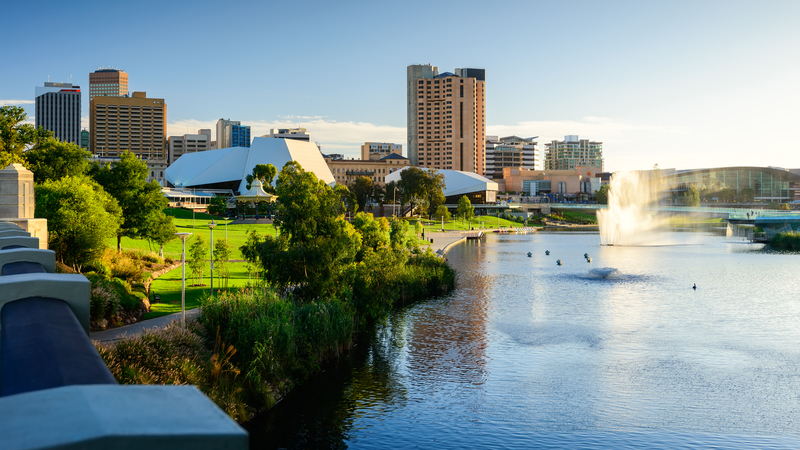The SA-PRC economic relationship
July 17 2020

A May 2020 report published by the Australia-China Relations Institute at the University of Technology Sydney pointed to demand from the People’s Republic of China (PRC) – underpinned by deep economic complementarities and purchasing power – as the chief drivers of growth in Australian exports.[1] This extends to South Australia, with a prominent example of this being rapid growth in PRC consumer demand for South Australian wine. This factsheet provides an overview of SA’s economic relationship with the PRC.
1. In the year to May 2020, the value of South Australian goods exports to the PRC was $3.0 billion,[2] equivalent to 2.7 percent of Gross State Product.[3]
2. Exports to the PRC account for 27.2 percent of total SA goods exports. This compares with:[4]
- 8.3 percent to the US;
- 7.1 percent to Malaysia; and
- 5.6 percent to Canada.
2. SA goods exports reached $11.2 billion in 2019, having grown by 34.6 percent over the last decade. Growth in goods exports to the PRC is responsible for 57.3 percent of this.[5]
3. In 2019, agriculture, forestry and fisheries exports accounted for 49.2 percent of SA’s goods exports to the PRC, followed by minerals and fuels (25.1 percent), manufactures (24.2 percent) and other goods (1.6 percent).[6]
- Alcoholic beverages alone accounted for 30.3 percent of total goods exports to the PRC.
4. In the first five months of 2020, SA’s goods exports to the PRC grew by 15.1 percent compared to the same period last year, despite the economic shock of the COVID-19 pandemic.[7] This was driven by exports of copper, iron ore and alcoholic beverages, which together accounted for 59.7 percent of goods exports to the PRC during this period.[8]
5. SA’s service exports were worth $3.6 billion in 2018-19, led by personal travel related to education worth $1.9 billion and personal travel unrelated to education worth $804 million.[9]
- As of April 2020, there were 10,760 PRC students in SA, with 7352 of these in higher education institutions. PRC students accounted for 29.7 percent of all international students and 33.3 percent of those in higher education institutions.[10]
- In 2019, there were 66,000 visitors to SA from both the UK and the PRC. Visitors from the PRC spent a cumulative $384 million. In comparison, those from the UK cumulatively spent $72 million.[11]
6. SA received $38 million in PRC investment in 2019, representing one percent of PRC investment in Australia and a 94.1 percent decrease from 2018. This is also the lowest level of PRC investment in SA since 2014.[12]
This fact sheet was prepared by Michael Zhou, Project and Research Officer at the Australia-China Relations Institute, University of Technology Sydney.
Sources
[1] James Laurenceson, Michael Zhou, COVID-19 and the Australia-China relationship's zombie economic idea, Australia-China Relations Institute, University of Technology Sydney, May 7 2020 <https://www.australiachinarelations.org/content/covid-19-and-australia-china-relationship%E2%80%99s-zombie-economic-idea>.
[2] Australian Bureau of Statistics, ‘5368.0 – international trade in goods and services, Australia, May 2020’, May 2 2020 <https://www.abs.gov.au/AUSSTATS/abs@.nsf/DetailsPage/5368.0May%202020?OpenDocument>.
[3] The figure for Gross State Product is for 2018-19. Source: Australian Bureau of Statistics, ‘5220.0 – Australian national accounts: state accounts, 2018-19’, November 15 2019 <https://www.abs.gov.au/AUSSTATS/abs@.nsf/DetailsPage/5220.02018-19?OpenDocument>.
[4] Australian Bureau of Statistics, ‘5368.0 – international trade in goods and services, Australia, May 2020’, May 2 2020 <https://www.abs.gov.au/AUSSTATS/abs@.nsf/DetailsPage/5368.0May%202020?OpenDocument>.
[5] Ibid.
[6] Australian Government Department of Foreign Affairs and Trade, ‘Trade statistical pivot tables’, May 2020 <https://www.dfat.gov.au/about-us/publications/Pages/trade-statistical-pivot-tables>.
[7] Australian Bureau of Statistics, ‘5368.0 – international trade in goods and services, Australia, May 2020’, May 2 2020 <https://www.abs.gov.au/AUSSTATS/abs@.nsf/DetailsPage/5368.0May%202020?OpenDocument>.
[8] Australian Bureau of Statistics, ‘Merchandise exports – ($ thousands): exports by SITC’, 2020 <http://stat.data.abs.gov.au/>.
[9] Australian Bureau of Statistics, ‘5368.0.55.003 – international trade: supplementary information, financial year, 2018-19’, November 21 2019 <https://www.abs.gov.au/AUSSTATS/abs@.nsf/DetailsPage/5368.0.55.0032018-19?OpenDocument>.
[10] Australian Government Department of Education, Skills and Employment, ‘International student data 2020’, 2020 <https://internationaleducation.gov.au/research/International-Student-Data/Pages/InternationalStudentData2020.aspx>.
[11] South Australian Tourism Commission, ‘International performance to December 2019’, April 8 2020 <https://tourism.sa.gov.au/documents/CORP/documentMedia.ashx?A={FCE9D9F3-C1C5-47D2-8340-E03557F274C6}&B=False>.
[12] Doug Ferguson, Helen Zhi Dent, Hans Hendrischke, Wei Li, Sissi Qian, Demystifying Chinese Investment in Australia – June 2020, KPMG; University of Sydney, June 9 2020 <https://home.kpmg/au/en/home/insights/2020/06/demystifying-chinese-investment-in-australia-june-2020.html>.

